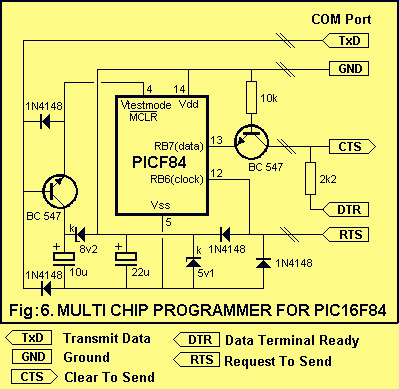
infrared IR proximity detector/ IR beam barrier circuit diagram

The circuit employs a widely used Sharp IR module (the Vishay module may also be utilized). The pin numbers indicated in the circuit pertain to both the Sharp and Vishay modules. For other modules, it is recommended to consult their respective datasheets. The receiver incorporates a 555 timer IC functioning as an oscillator at approximately 38 kHz (operating within a range of 36 kHz to 40 kHz), which must be adjusted using a 10K preset resistor. The duty cycle of the IR beam is around 10%, allowing for increased current to flow through the LEDs, thereby achieving an extended range. The receiver utilizes a Sharp IR module; when the IR beam from the transmitter strikes the IR module, the output is activated, which in turn activates the relay and deactivates when the beam is obstructed. The relay contacts can be employed to control alarms, lights, etc. The 10K preset should be adjusted until the receiver successfully detects the IR beam. The circuit can also function as a proximity sensor, enabling the detection of objects in front of the device without obstructing the IR beam. For this purpose, the LEDs should be aligned in the same direction as the IR module and at the same height. The recommended configuration is illustrated in the circuit diagram. The LEDs should be adequately shielded with a reflective material, such as glass or aluminum foil, on the sides to minimize the dispersion of the IR beam and to maintain a focused beam. When there are no objects in front, the IR beam is not reflected onto the module, and consequently, the circuit remains inactive. Conversely, when an object approaches the device, the IR light emitted from the LEDs is reflected by the object onto the module, thus activating the circuit.
The circuit design primarily revolves around the integration of the Sharp IR module and a 555 timer IC. The 555 timer is configured in an astable mode, generating a continuous square wave signal at the designated frequency, which is crucial for the modulation of the IR beam. The frequency of approximately 38 kHz is significant as it aligns with the sensitivity range of most IR receivers, ensuring optimal performance. The 10K preset resistor allows for fine-tuning of the oscillator frequency, which is essential for adapting the circuit to various environmental conditions and module specifications.
The IR transmitter comprises a series of LEDs, which emit infrared light. The alignment of these LEDs with the IR receiver is critical for maximizing detection range and reliability. The use of reflective materials around the LEDs serves to concentrate the emitted IR light, minimizing losses due to scattering and enhancing the effective range of the sensor.
When an object enters the detection zone, the IR light is reflected back towards the IR module, triggering a change in the output state of the module. This output can be interfaced with a relay, enabling the control of various devices such as alarms or lighting systems. The relay acts as a switch, allowing for a higher power load to be controlled by the low power output from the IR module.
In proximity sensing applications, the circuit can effectively detect the presence of objects without requiring direct line-of-sight. This capability is particularly useful in automation systems, security applications, and interactive devices. The circuit's versatility allows it to be implemented in various scenarios, making it a valuable addition to electronic projects focused on object detection and automation.The circuit uses the very popular Sharp IR module (Vishay module can also be used). The pin nos. shown in the circuit are for the Sharp & VIshay modules. For other modules please refer to their respective datasheets. The receiver consists of a 555 timer IC working as an oscillator at about 38Khz (also works from 36kHz to 40kHz) which has to be adj usted using the 10K preset. The duty cycle of the IR beam is about 10%. This allows us to pass more current through the LEDS thus achieving a longer range. The receiver uses a sharp IR module. When the IR beam from the transmitter falls on the IR module, the output is activated which activates the relay and de-activated when the beam is obstructed. The relay contacts can be used to turn ON/OFF alarms, lights etc. The 10K preset should be adjusted until the receiver detects the IR beam. The circuit can also be used as a proximity sensor, i. e to detect objects in front of the device without obstructing a IR beam. For this the LEDs should be pointed in the same direction as the IR module and at the same level. The suggested arrangement is shown in the circuit diagram. The LEDs should be properly covered with a reflective material like glass or aluminum foils on the sides to avoid the spreading of the IR beam and to get a sharp focus of the beam.
When there is nothing in front of them, the IR beam is not reflected onto the module and hence the circuit is not activated. When an object comes near the device, the IR light from the LEDs is reflected by the object onto the module and hence the circuit gets activated.
🔗 External reference
The circuit design primarily revolves around the integration of the Sharp IR module and a 555 timer IC. The 555 timer is configured in an astable mode, generating a continuous square wave signal at the designated frequency, which is crucial for the modulation of the IR beam. The frequency of approximately 38 kHz is significant as it aligns with the sensitivity range of most IR receivers, ensuring optimal performance. The 10K preset resistor allows for fine-tuning of the oscillator frequency, which is essential for adapting the circuit to various environmental conditions and module specifications.
The IR transmitter comprises a series of LEDs, which emit infrared light. The alignment of these LEDs with the IR receiver is critical for maximizing detection range and reliability. The use of reflective materials around the LEDs serves to concentrate the emitted IR light, minimizing losses due to scattering and enhancing the effective range of the sensor.
When an object enters the detection zone, the IR light is reflected back towards the IR module, triggering a change in the output state of the module. This output can be interfaced with a relay, enabling the control of various devices such as alarms or lighting systems. The relay acts as a switch, allowing for a higher power load to be controlled by the low power output from the IR module.
In proximity sensing applications, the circuit can effectively detect the presence of objects without requiring direct line-of-sight. This capability is particularly useful in automation systems, security applications, and interactive devices. The circuit's versatility allows it to be implemented in various scenarios, making it a valuable addition to electronic projects focused on object detection and automation.The circuit uses the very popular Sharp IR module (Vishay module can also be used). The pin nos. shown in the circuit are for the Sharp & VIshay modules. For other modules please refer to their respective datasheets. The receiver consists of a 555 timer IC working as an oscillator at about 38Khz (also works from 36kHz to 40kHz) which has to be adj usted using the 10K preset. The duty cycle of the IR beam is about 10%. This allows us to pass more current through the LEDS thus achieving a longer range. The receiver uses a sharp IR module. When the IR beam from the transmitter falls on the IR module, the output is activated which activates the relay and de-activated when the beam is obstructed. The relay contacts can be used to turn ON/OFF alarms, lights etc. The 10K preset should be adjusted until the receiver detects the IR beam. The circuit can also be used as a proximity sensor, i. e to detect objects in front of the device without obstructing a IR beam. For this the LEDs should be pointed in the same direction as the IR module and at the same level. The suggested arrangement is shown in the circuit diagram. The LEDs should be properly covered with a reflective material like glass or aluminum foils on the sides to avoid the spreading of the IR beam and to get a sharp focus of the beam.
When there is nothing in front of them, the IR beam is not reflected onto the module and hence the circuit is not activated. When an object comes near the device, the IR light from the LEDs is reflected by the object onto the module and hence the circuit gets activated.
🔗 External reference





